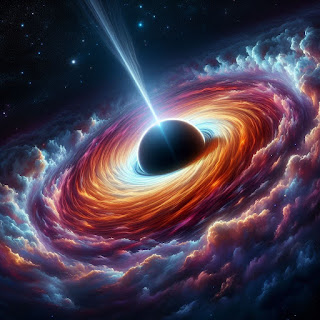Blackhole The very name conjures images of cosmic monsters, swallowing up anything that gets too close. But the reality, while still mind-bending, is even more fascinating than science fiction could dream up. Let's take a dive into these mysterious giants of the universe:
Spacetime Slingshot: Imagine gravity, not as a gentle pull, but as a colossal cosmic trampoline. That's essentially what a black hole is. Its immense mass warps spacetime itself, creating a region where gravity is so strong not even light can escape. Think of it as a one-way door for anything that crosses the event horizon, the point of no return.
Cosmic Detectives: We can't directly see black holes, but we know they're out there thanks to their gravitational influence. Imagine a cosmic game of tug-of-war, where stars near a black hole get stretched and whipped around like cosmic yo-yos. By studying these stellar tantrums, astronomers can deduce the presence and even estimate the size of these invisible leviathans.
Black Hole Bonanza: Black holes aren't just galactic vacuum cleaners. They can be surprisingly active! When material falls into a black hole, it heats up to millions of degrees, spewing out jets of incredibly hot plasma that can shoot across vast distances. Imagine a cosmic fire hydrant blasting cosmic soup across the universe!
The Big Crunch or the Big Bounce? What happens to the stuff that falls into a black hole? Does it disappear forever, or is there something more going on? Some theories suggest that matter gets crushed and its information encoded in the fabric of spacetime itself. Others propose that black holes might be portals to another universe, where matter gets spat out in a "white hole." The jury's still out, but the possibilities are mind-boggling!
Black Holes: Cosmic Guardians? While their reputation might be fearsome, black holes could actually be the guardians of galaxies. Their immense gravity helps shape and stabilize galactic ecosystems, preventing stars from flinging themselves out into the cosmic void. Think of them as galactic anchors, keeping everything in its place.
So, the next time you gaze up at the night sky, remember the unseen giants lurking out there. Black holes are a testament to the universe's strangeness and wonder, a reminder that the cosmos is full of mysteries waiting to be unraveled. And who knows, maybe one day we'll even peek past the event horizon and see what lies beyond.
Stay Curious!
Remember, the universe is a vast and wondrous place, and black holes are just one of its many fascinating oddities. Keep exploring, keep questioning, and never stop being amazed by the sheer awesomeness of it all.
Stellar dynamics is that the branch of uranology that describes in an exceedingly applied mathematics means the collective motions of stars subject to their mutual gravity. The essential distinction from uranology is that every star contributes a lot of or less equally to the overall field of force, whereas in uranology the pull of a vast body dominates any satellite orbits. Historically, the ways used in stellar dynamics originated from the fields of each mechanics and physics. In essence, the elemental drawback of stellar dynamics is that the N-body drawback, wherever the N members ask the members of a given stellar system. Given the big variety of objects in an exceedingly stellar system, stellar dynamics is sometimes involved with the a lot of international, applied mathematics properties of many orbits instead of with the particular knowledge on the positions and velocities of individual orbits. The motions of stars in an exceedingly ga...




Comments
Post a Comment